

Collections Education: The Extended Specimen and Data Acumen. Skip to Main Content Advertisement Books Search Close Advanced Search Search Menu Article Navigation Article Contents.

Great talk by @AlexHardisty at #biodigi2021 on #digextspecimen - ‘Open Digital Specimen’ (openDS) + ‘Biodiversity Data-as-Infrastrcuture’ concepts we need to embrace - both natural history collection staff + researchers using collections need to utilize t. Persistent Identifiers at the Natural History Museum. Implementing a Community Vision for the Future of Biodiversity Collections. Skip to Main Content Advertisement Search Close Advanced Search Search Menu Skip Nav Destination Article Navigation Article Contents.
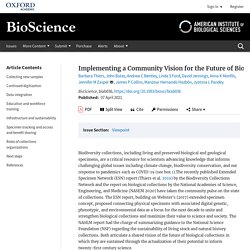
Icedig. SCHOLIX. The next generation of natural history collections. Abstract The last 50 years have witnessed rapid changes in the ways that natural history specimens are collected, preserved, analyzed, and documented.
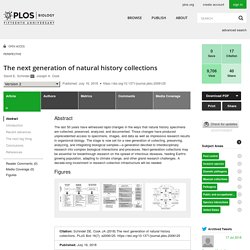
Those changes have produced unprecedented access to specimens, images, and data as well as impressive research results in organismal biology. The stage is now set for a new generation of collecting, preserving, analyzing, and integrating biological samples—a generation devoted to interdisciplinary research into complex biological interactions and processes. Emerging Frontiers in Collections-Based Ornithological Research. Consortium of European Taxonomic Facilities. Essential Biodiversity Variables. Towards a European Research Infrastructure for Scientific Collections. RBGE is a partner in an ambitious initiative to create a Distributed System of Scientific Collections (DiSSCo) as a new European Research Infrastructure.
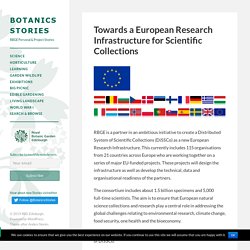
This currently includes 115 organisations from 21 countries across Europe who are working together on a series of major EU-funded projects. These projects will design the infrastructure as well as develop the technical, data and organisational readiness of the partners. The consortium includes about 1.5 billion specimens and 5,000 full-time scientists. The aim is to ensure that European natural science collections and research play a central role in addressing the global challenges relating to environmental research, climate change, food security, one health and the bioeconomy. There are four main projects currently supporting the development of DiSSCo: RBGE is actively involved in the first two of these projects.
RBGE is leading on three Tasks within the project. The project started in February 2019 and will run until January 2023. Towards a digital natural history museum. These notes are the result of a few events I've been involved in the last couple of months, including TDWG 2017 in Ottawa, a thesis defence in Paris, and a meeting of the Science Advisory Board of the Natural History Museum in London.
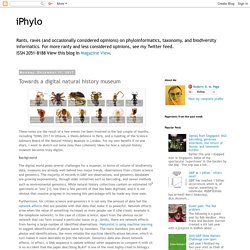
For my own benefit if no one else's, I want to sketch out some (less than coherent) ideas for how a natural history museum becomes truly digital. Background The digital world poses several challenges for a museum. Biodiversity Cyberbank. Powellcenter.usgs.gov. BCoN Reports January 2019: extended specimens. Ozymandias: a biodiversity knowledge graph. Introduction “Linnaeus would have been a ‘techie”’ (Godfray, 2007) The recent announcement that the Global Biodiversity Information Facility (GBIF, has reached the milestone of one billion occurrence records reflects the considerable success the biodiversity community has had in mobilising data.
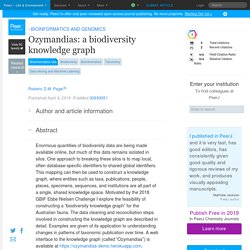
Much of this success comes from standardising on a simple column-based data format (Darwin Core) (Wieczorek et al., 2012) and indexing that data using three fields: taxonomic name, geographic location, and date (i.e., “what”, “where”, and “when”). By flattening the data into a single table, Darwin Core makes data easy to enter and view, but at the cost of potentially obscuring relationships between entities, relationships that may be better represented using a network.
Organization. Data Observation Network for Earth's (DataONE's) foundation for excellence is the expertise and established partnerships among participating organizations that have multi-decade expertise in a wide range of fields including: existing archive initiatives, libraries, environmental observing systems and research networks, data and information management, science synthesis centers, and professional societies.
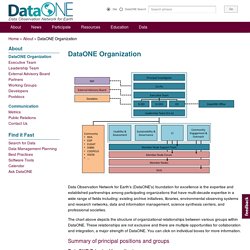
The chart above depicts the structure of organizational relationships between various groups within DataONE. Extended Specimen Network: A Strategy to Enhance US Biodiversity Collections, Promote Research and Education. We use cookies to enhance your experience on our website.By continuing to use our website, you are agreeing to our use of cookies.
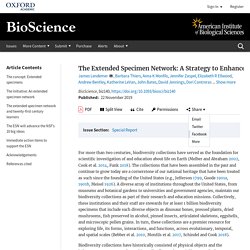
You can change your cookie settings at any time. FAIR DIGITAL OBJECTS driving worldwide interoperability FAIR DIGITAL OBJECTS driving worldwide interoperability Experts worldwide are discussing FAIR Digital Objects (FDO) as the smallest FAIR technical components with maximum freedom to operate.
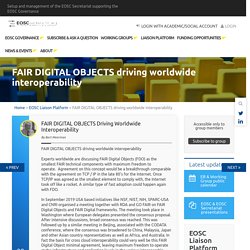
Agreement on this concept would be a breakthrough comparable with the agreement on TCP / IP in the late 80’s for the Internet. Once TCP/IP was agreed as the smallest element to comply with, the Internet took off like a rocket. A similar type of fast adoption could happen again with FDO. OpenDS - A new standard for digital specimens. Welcome GLOBIS-B. Paris Musées embraces open access. How was the policy developed?
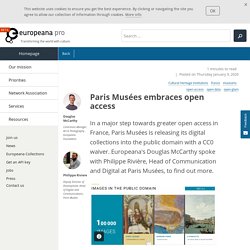
Who were the key players? Over a number of years, we worked through different scenarios that we could imagine for our images. This project team was composed of staff from departments across the organisation, including digital, collections, legal, iconographers, museum directors and so on. Each scenario was evaluated against international benchmarks and then analysed in relation to Paris Musées in term of costs, personnel organisation, user legibility, etc. Gradually we eliminated some scenarios and focused more closely on others; we kept working to find the best scenario. What are EBVs? Essential Biodiversity Variables. EBVs are the abbreviation for Essential Biodiversity Variables. These Essential Biodiversity Variables, defined as the derived measurements required to study, report, and manage biodiversity change, focusing on status and trend in elements of biodiversity should play the role of brokers between monitoring initiatives and decision makers.
They provide the first level of abstraction between low-level primary observations and high-level indicators of biodiversity. Criteria for Essential Biodiversity Variables. EBVs: Essential biodiversity variables. About Us – Creative-b. Concepts. LifeWatch-ERIC - Lifewatch. Our Mission & Vision The European Commission recognises research in biodiversity and ecosystems as a priority, moving further from the punctual programmes funding the many fixed-term projects, to the institution of the 14th European Research Infrastructure Consortium, LifeWatch-ERIC*, as a long term strategy to ensure sustainability of research. Europeana Topics. Www.esfri.eu. Home - DiSSCo. Digital Object Architecture.